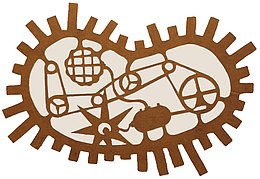Cyborg Systems: Sociology's Proper Unit of Analysis
 The increasing centrality of the Internet in our daily lives has precipitated a spate of theorizing about how we – as humans and as a society – are changing (or not) due to the constant technological mediation of our most basic interactions and activities. Let’s face it: This sort of theorizing is populated mostly by men of considerable privilege (with some very notable exceptions). A cynic might hold that the problems concerning human techno-social interactions are relatively insignificant compared to more pressing issues of race, class, gender, age, etc. One cannot but be sympathetic to such charges.
The increasing centrality of the Internet in our daily lives has precipitated a spate of theorizing about how we – as humans and as a society – are changing (or not) due to the constant technological mediation of our most basic interactions and activities. Let’s face it: This sort of theorizing is populated mostly by men of considerable privilege (with some very notable exceptions). A cynic might hold that the problems concerning human techno-social interactions are relatively insignificant compared to more pressing issues of race, class, gender, age, etc. One cannot but be sympathetic to such charges.
However, I would posit that a complicated set of processes are at work in causing many to view theory surrounding the Internet and its ever-expanding litany of technical terms (e.g., Web 2.0, prosumption, produsage, playbor, or sousveillance) as largely irrelevant to the salient social issues of our day: 1.) The theorists of the Web, tending to work from a position of privilege, perhaps, simply lack awareness of feminist and other situated discourses, thus failing to acknowledge their relevance. 2.) Privilege may also account for a willingness to be satisfied by grand theoretical projects that produce political objectives couched in inaccessible language, too impractical to be actionable, altogether irrelevant, or simply nonexistent. 3.) Disciplinary specialization is such that the theorists from Marxian, post-structuralist, and/or science and technology studies traditions who are studying similar phenomena may not be in dialogue with one another.
Looking to Donna Haraway, I believe there is a case to be made that information/communication technologies and the politics of race, gender, age, and class are becoming increasingly difficult to separate out in the 21st Century. This claim goes beyond the simple empirical facts that people at the intersections of these categories tend to access (or not) and use technologies differently – observations generally classified as “the digital divide.”
All such categories, however real in their effects, are rooted in basic assumptions about what it means to be human – what theorists like to call “ontology.” Haraway observes that technological advancements have blurred the boundaries between human and machines, making “thoroughly ambiguous the difference between natural and artificial, mind and body, self-developing and externally designed, and many other distinctions that apply to organisms and machines.” Machines themselves are just structuring systems, and they need not be made of metal and glass – they could, for example, describe the materials and practices of a variety of social institutions. The Internet is only the latest phase in a trend toward the dissolution of conceptual boundaries between humans and society, humans and animals, and humans and machines. Thus it makes sense to follow her lead in championing the metaphor of the “cyborg.”
The avatar epitomizes this cyborg-like dissolution of such boundaries on the Internet, allowing us quite literally to be human and machine (as well as human and animal if we chose to represent ourselves in that way), all the while, being embodied through an invisible code – a medium which both produces and constricts us and whose production is always organized with respect to a whole host of social processes. No doubt, the divisions of race, class, age, gender and many other such social categories will persist like so many ghosts in the mechanics of the Internet. In such a context, the concept of intersectionality takes on a profound new meaning, because, for every new way of being human that emerges, so too does a new context in which race, class, age, and gender will play out in novel ways. More specifically, we have little reason to think that the salient social problems of our contemporary world will not re-emerge (perhaps even more insidiously) within the ostensibly more democratic and diffused socio-technological structures organizing human existence online. Yet, as Haraway makes clear, we cannot opt out of these systems. Technology shapes all of human existence however direct our participation in its most visible structures.
Thus, I believe it is imperative that we all respond to the call-to-action Haraway set forth in a recent interview:
[…] we had better get it – this is a worlding operation. Never the only worlding operation going on, but one that we had better inhabit as more than a victim. We had better get it that domination is not the only thing going on here. We had better get it that this is a zone where we had better be the movers and the shakers, or we will be just victims.
![]() “When We Have Never Been Human, What Is to Be Done?: Interview with Donna Haraway,” by Nicholas Gane, in Theory Culture Society, 2006; 23; 135.
“When We Have Never Been Human, What Is to Be Done?: Interview with Donna Haraway,” by Nicholas Gane, in Theory Culture Society, 2006; 23; 135.
![]() “Cyberfeminism,” by Jenny Sundén, in The International Encyclopedia of Communication.
“Cyberfeminism,” by Jenny Sundén, in The International Encyclopedia of Communication.
Add to: Facebook | Digg | Del.icio.us | Stumbleupon | Reddit | Blinklist | Twitter | Technorati | Yahoo Buzz | Newsvine




1468-0491/asset/society_affiliation_image.gif?v=1&s=859caf337f44d9bf73120debe8a7ad67751a0209)
The three problems that you identify–in linking theories of technology to the lives of “others” in society–are old problems in social theories. Lemert’s designation of professional theorists and non-professional theorists recognizes that there might be a way to make theories relevant. This is to reach out to the publics who are engaged in theoretical thinking daily.
Keri